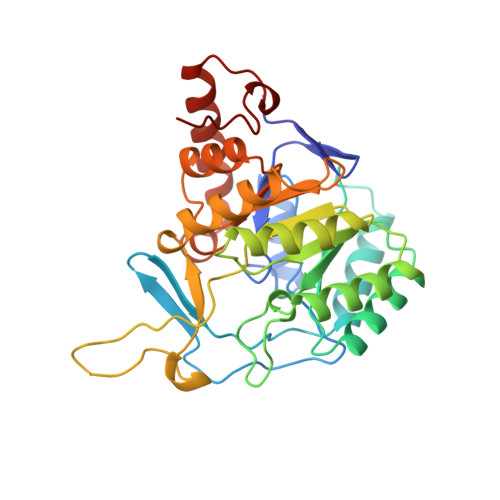The crystal structure of Lactococcus lactis dihydroorotate dehydrogenase A complexed with the enzyme reaction product throws light on its enzymatic function.
Rowland, P., Bjornberg, O., Nielsen, F.S., Jensen, K.F., Larsen, S.(1998) Protein Sci 7: 1269-1279
- PubMed: 9655329
- DOI: https://doi.org/10.1002/pro.5560070601
- Primary Citation of Related Structures:
2DOR - PubMed Abstract:
Dihydroorotate dehydrogenases (DHODs) catalyze the oxidation of (S)-dihydroorotate to orotate, the fourth step and only redox reaction in the de novo biosynthesis of pyrimidine nucleotides. A description is given of the crystal structure of Lactococcus lactis dihydroorotate dehydrogenase A (DHODA) complexed with the product of the enzyme reaction orotate. The structure of the complex to 2.0 A resolution has been compared with the structure of the native enzyme. The active site of DHODA is known to contain a water filled cavity buried beneath a highly conserved and flexible loop. In the complex the orotate displaces the water molecules from the active site and stacks above the DHODA flavin isoalloxazine ring, causing only small movements of the surrounding protein residues. The orotate is completely buried beneath the protein surface, and the orotate binding causes a significant reduction in the mobility of the active site loop. The orotate is bound by four conserved asparagine side chains (Asn 67, Asn 127, Asn 132, and Asn 193), the side chains of Lys 43 and Ser 194, and the main chain NH groups of Met 69, Gly 70, and Leu 71. Of these the Lys 43 side chain makes hydrogen bonds to both the flavin isoalloxazine ring and the carboxylate group of the orotate. Potential interactions with bound dihydroorotate are considered using the orotate complex as a basis for molecular modeling. The role of Cys 130 as the active site base is discussed, and the sequence conservation of the active site residues across the different families of DHODs is reviewed, along with implications for differences in substrate binding and in the catalytic mechanisms between these families.
Organizational Affiliation:
Centre for Crystallographic Studies, Department of Chemistry, University of Copenhagen, Denmark.
















